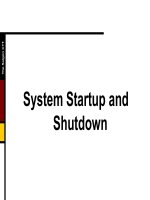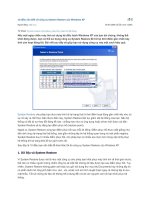Assembly system issue
Bạn đang xem bản rút gọn của tài liệu. Xem và tải ngay bản đầy đủ của tài liệu tại đây (115.68 KB, 33 trang )
Assembly System Design Issues
• Goals of this class
– understand basic decisions in assembly system design
– look at some typical lines for small and large products
– different types of assembly machinery
– example lines from industry
AITL Sys Des 11/5/2004 © Daniel E Whitney 1
Basic Factors in System Design
• Capacity planning - required number of units/year
• Resource choice - assembly methods
• Task assignment
• Floor layout
• Workstation design
• Material handling and work transport
• Part feeding and presentation
• Quality
• Economic analysis
• Personnel training and participation
AITL Sys Des 11/5/2004 © Daniel E Whitney 2
Basic Decision Process
Image removed for copyright reasons.
Source:
Figure 16-1 in [Whitney 2004] Whitney, D. E. Mechanical Assemblies: Their Design, Manufacture,
and Role in Product Development. New York, NY: Oxford University Press, 2004. ISBN: 0195157826.
AITL Sys Des 11/5/2004 © Daniel E Whitney 3
Available Methods
• Seat of the pants
• The supplier’s method, using his equipment
• Trial and error, using simulation to evaluate
• Analytical methods using math programming or
heuristics
• Combination of technical and economic factors
and inequality constraints make this a hard
problem
AITL Sys Des 11/5/2004 © Daniel E Whitney 4
The Basic Tradeoffs
Image removed for copyright reasons.
Source:
Figure 16-4 in [Whitney 2004] Whitney, D. E. Mechanical Assemblies: Their Design, Manufacture,
and Role in Product Development. New York, NY: Oxford University Press, 2004. ISBN: 0195157826.
AITL Sys Des 11/5/2004 © Daniel E Whitney 5
Unit Cost Example
Unit Assembly Cost by Three Methods
f AC =0.38
T=2s
L H=$15/hr
S$=50000
$/tool = $10000
N = 10 parts/unit
w = 0.25 workers/sta
Image removed for copyright reasons.
Source:
Figure 16-5 in [Whitney 2004] Whitney, D. E. Mechanical Assemblies: Their Design, Manufacture,
and Role in Product Development. New York, NY: Oxford University Press, 2004. ISBN: 0195157826.
AITL Sys Des 11/5/2004 © Daniel E Whitney 6
Characteristics of Manual Assembly
• Technical
– dexterous, able to learn and improve, flexible
– can overlap operations - move+flip+inspect
– may be too innovative, or may be unable to repeat
exactly the operation or the cycle time
• Economic
– top speed dictates need for more people to get more
output (called variable cost)
AITL Sys Des 11/5/2004 © Daniel E Whitney 7
Cellular Assembly Line
Image removed for copyright reasons.
Source:
Figure 16-14 in [Whitney 2004] Whitney, D. E. Mechanical Assemblies: Their Design, Manufacture,
and Role in Product Development. New York, NY: Oxford University Press, 2004. ISBN: 0195157826.
One station Whole line
AITL Sys Des 11/5/2004 © Daniel E Whitney 8
Characteristics of Fixed Automation
• Technical
– simple operations with few DoF and simple alternatives
– each station is dedicated to one operation
(place/fasten/confirm) built from standard modules
strung together
– small parts, relatively high speed
– basic architectures include in-line and rotary
• Economic
– the investment is in fixed increments regardless of
required capacity (fixed cost)
– the payoff is in keeping uptime high (many stories)
AITL Sys Des 11/5/2004 © Daniel E Whitney 9
Typical Cam-operated Assembly Machine
Image removed for copyright reasons.
Source:
Figure 16-6 in [Whitney 2004] Whitney, D. E. Mechanical Assemblies: Their Design, Manufacture,
and Role in Product Development. New York, NY: Oxford University Press, 2004. ISBN: 0195157826.
AITL Sys Des 11/5/2004 © Daniel E Whitney 10
Typical Dial Machine
Same principle used
by Gillette for Mach 3
razors
Images removed for copyright reasons.
Source:
Figure 16-8 in [Whitney 2004] Whitney, D. E. Mechanical Assemblies: Their Design, Manufacture,
and Role in Product Development. New York, NY: Oxford University Press, 2004. ISBN: 0195157826.
AITL Sys Des 11/5/2004 © Daniel E Whitney 11
Characteristics of Flexible Automation
• Technical
– multiple motion axes
– motion (gross and fine) modulated by sensing and
decisions
– multiple tasks with or without tool change
• Economic
– multiple tasks (within a cycle or next year)
– investment scalable to demand (variable cost)
– tools and parts presentation costly (fixed cost)
AITL Sys Des 11/5/2004 © Daniel E Whitney 14
Sony VCR Assembly System
Image removed for copyright reasons.
Source:
Figure 17-22 in [Whitney 2004] Whitney, D. E. Mechanical Assemblies: Their Design, Manufacture,
and Role in Product Development. New York, NY: Oxford University Press, 2004. ISBN: 0195157826.
AITL Sys Des 11/5/2004 © Daniel E Whitney 15
Line Architectures
• Single serial line (car or airplane final assembly)
• Fishbone serial line with subassembly feeder lines
(transmissions, axles)
• Loop (common for automated lines)
• U-shape cell (often used with people)
• Rotary dial (used for very short production cycle
work with a single long task cycle like filling
bottles)
• Transport can be synchronous or asynchronous
AITL Sys Des 11/5/2004 © Daniel E Whitney 16
Serial and Parallel Line Arrangements
Image removed for copyright reasons.
Source:
Figure 16-9 in [Whitney 2004] Whitney, D. E. Mechanical Assemblies: Their Design, Manufacture,
and Role in Product Development. New York, NY: Oxford University Press, 2004. ISBN: 0195157826.
How do they compare on tool cost, reliability, time, flexibility?
AITL Sys Des 11/5/2004 © Daniel E Whitney 17
Serial Line with Multiple Stations
Image removed for copyright reasons.
Source:
Figure 16-10(a) in [Whitney 2004] Whitney, D. E. Mechanical Assemblies: Their Design, Manufacture,
and Role in Product Development. New York, NY: Oxford University Press, 2004. ISBN: 0195157826.
(A) THREE COPIES OF STATION 3 ARE NEEDED BECAUSE
ITS TASK TAKES SO LONG
AITL Sys Des 11/5/2004 © Daniel E Whitney 18
Serial Line with Uneven Task Assignment
Image removed for copyright reasons.
Source:
Figure 16-10(b) in [Whitney 2004] Whitney, D. E. Mechanical Assemblies: Their Design, Manufacture,
and Role in Product Development. New York, NY: Oxford University Press, 2004. ISBN: 0195157826.
(B) GROUPING WORK AT STATIONS IMPROVES
BALANCE OF STATION TIMES
AITL Sys Des 11/5/2004 © Daniel E Whitney 19
Multiple Paths Are Good and Bad
Image removed for copyright reasons.
Source:
Figure 16-11 in [Whitney 2004] Whitney, D. E. Mechanical Assemblies: Their Design, Manufacture,
and Role in Product Development. New York, NY: Oxford University Press, 2004. ISBN: 0195157826.
THERE ARE 6 POSSIBLE PATHS
AITL Sys Des 11/5/2004 © Daniel E Whitney 20
Buffers - Conservative Design
• They insulate the line from stopped stations
• The only buffers that matter are the ones just
ahead and after the bottleneck station (the one
whose speed paces the line)
• But it is often hard to tell which station is the
bottleneck
• Since a blocked buffer is as bad as a starved one,
the ideal state of a buffer is half full
• Let a = the average number of cycles to fix a
simple breakdown; b = buffer capacity
• Then if b/2=a, there will be enough parts in the
buffer to keep everything going while a simple
breakdown is fixed
AITL Sys Des 11/5/2004 21
© Daniel E Whitney
Single Piece Flow
• Necessary for big things like airplanes
• Not necessary for little things
• The alternative is batch transport
– This creates work in process inventory, takes up space,
and seems associated with big inefficient factories (see
research by Prof Cochran)
– Errors can hide in the batch and the whole thing might
have to be thrown away
– Transport is infrequent so transport resources can be
shared
– Creates a transport mafia and finger pointing (VW
engine plant story)
AITL Sys Des 11/5/2004 © Daniel E Whitney 22









